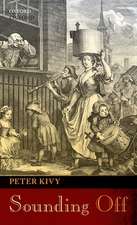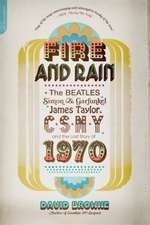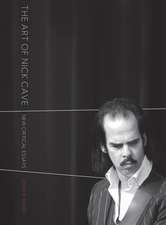The Ashgate Research Companion to Japanese Music: SOAS Studies in Music
Autor David W. Hughes Editat de Alison McQueen Tokitaen Limba Engleză Hardback – 22 oct 2008
Din seria SOAS Studies in Music
- 9%
 Preț: 868.79 lei
Preț: 868.79 lei -
 Preț: 341.55 lei
Preț: 341.55 lei - 9%
 Preț: 936.95 lei
Preț: 936.95 lei - 9%
 Preț: 866.59 lei
Preț: 866.59 lei -
 Preț: 311.18 lei
Preț: 311.18 lei -
 Preț: 341.08 lei
Preț: 341.08 lei - 9%
 Preț: 866.79 lei
Preț: 866.79 lei -
 Preț: 311.41 lei
Preț: 311.41 lei -
 Preț: 297.49 lei
Preț: 297.49 lei -
 Preț: 370.22 lei
Preț: 370.22 lei - 18%
 Preț: 1063.31 lei
Preț: 1063.31 lei - 25%
 Preț: 768.69 lei
Preț: 768.69 lei - 18%
 Preț: 1121.01 lei
Preț: 1121.01 lei - 26%
 Preț: 765.43 lei
Preț: 765.43 lei - 25%
 Preț: 766.66 lei
Preț: 766.66 lei - 18%
 Preț: 1060.25 lei
Preț: 1060.25 lei - 18%
 Preț: 1058.19 lei
Preț: 1058.19 lei - 18%
 Preț: 1063.41 lei
Preț: 1063.41 lei - 18%
 Preț: 1063.41 lei
Preț: 1063.41 lei - 25%
 Preț: 826.84 lei
Preț: 826.84 lei - 25%
 Preț: 823.17 lei
Preț: 823.17 lei - 18%
 Preț: 1053.16 lei
Preț: 1053.16 lei - 15%
 Preț: 239.96 lei
Preț: 239.96 lei - 18%
 Preț: 1050.09 lei
Preț: 1050.09 lei -
 Preț: 375.50 lei
Preț: 375.50 lei - 26%
 Preț: 765.01 lei
Preț: 765.01 lei - 26%
 Preț: 766.24 lei
Preț: 766.24 lei - 26%
 Preț: 822.34 lei
Preț: 822.34 lei - 18%
 Preț: 1061.06 lei
Preț: 1061.06 lei - 26%
 Preț: 765.43 lei
Preț: 765.43 lei - 26%
 Preț: 765.43 lei
Preț: 765.43 lei - 25%
 Preț: 769.10 lei
Preț: 769.10 lei - 18%
 Preț: 1061.93 lei
Preț: 1061.93 lei - 25%
 Preț: 768.69 lei
Preț: 768.69 lei - 18%
 Preț: 1059.45 lei
Preț: 1059.45 lei - 26%
 Preț: 734.25 lei
Preț: 734.25 lei - 18%
 Preț: 1108.37 lei
Preț: 1108.37 lei - 9%
 Preț: 1006.57 lei
Preț: 1006.57 lei - 18%
 Preț: 1051.55 lei
Preț: 1051.55 lei - 25%
 Preț: 767.88 lei
Preț: 767.88 lei - 26%
 Preț: 764.36 lei
Preț: 764.36 lei - 18%
 Preț: 1005.04 lei
Preț: 1005.04 lei - 18%
 Preț: 1008.97 lei
Preț: 1008.97 lei - 25%
 Preț: 825.21 lei
Preț: 825.21 lei - 26%
 Preț: 765.04 lei
Preț: 765.04 lei - 18%
 Preț: 1068.15 lei
Preț: 1068.15 lei - 26%
 Preț: 763.93 lei
Preț: 763.93 lei - 18%
 Preț: 1058.10 lei
Preț: 1058.10 lei
Preț: 776.84 lei
Preț vechi: 1034.83 lei
-25% Nou
Puncte Express: 1165
Preț estimativ în valută:
148.67€ • 153.37$ • 125.82£
148.67€ • 153.37$ • 125.82£
Carte tipărită la comandă
Livrare economică 04-18 martie
Preluare comenzi: 021 569.72.76
Specificații
ISBN-13: 9780754656999
ISBN-10: 0754656993
Pagini: 472
Ilustrații: Includes 81 b&w illustrations and 112 music examples
Dimensiuni: 169 x 244 x 37 mm
Greutate: 1.16 kg
Ediția:New ed
Editura: Taylor & Francis
Colecția Routledge
Seria SOAS Studies in Music
Locul publicării:Oxford, United Kingdom
ISBN-10: 0754656993
Pagini: 472
Ilustrații: Includes 81 b&w illustrations and 112 music examples
Dimensiuni: 169 x 244 x 37 mm
Greutate: 1.16 kg
Ediția:New ed
Editura: Taylor & Francis
Colecția Routledge
Seria SOAS Studies in Music
Locul publicării:Oxford, United Kingdom
Cuprins
Contents: Foreword; Context and change in Japanese music, Alison McQueen Tokita and David W. Hughes; Court and religious music (1): history of gagaku and shomyo, Steven G. Nelson; Court and religious music (2): music of gagaku and shomyo, Steven G. Nelson; The musical narrative of The Tale of the Heike, Komoda Haruko; The Kyushu biwa traditions, Hugh de Ferranti; No and kyogen: music from the medieval theatre, Fujita Takanori; The shakuhachi and its music, Tsukitani Tsuneko; Sokyoku-jiuta: Edo-period chamber music, Philip Flavin; Gidayu-bushi: music of the bunraku puppet theatre, Yamada Chieko; Music in kabuki: more than meets the eye, Alison McQueen Tokita; Popular music before the Meiji period, Gerald Groemer; Folk music: from local to national to global, David W. Hughes; The music of Ryukyu, Robin Thompson; The music of the Ainu, Chiba Nobuhiko; Popular music in modern Japan, Christine Yano and Hosokawa Shuhei; Western-influenced 'classical' music in Japan, Judith Ann Herd; Bibliography; Audio/videography; Index.
Notă biografică
Alison Tokita is Associate Professor in the School of Languages, Cultures and Linguistics, Monash University, Australia. David W. Hughes is Senior Lecturer in Ethnomusicology, Department of Music, School of Oriental and African Studies, University of London, UK.
Recenzii
'An excellent companion for anyone who wants to know about Japanese music whether it is a court, religious, theatrical, folk or popular genre. It is filled with the results of current research by Japanese and Western specialists and enriched with extensive examples in notation and on audio tracks. The book opens a new era in Japanese music studies.' William P. Malm, University of Michigan, USA ’... covers all periods and genres in great detail, and is much more than an overview. ... if you absorb the collected knowledge of this volume, you probably know more about the subject than the average Japanese. There are many music samples. ... an extensive bibliography (featuring enough works in western languages) is given, and an audio/videography ...The book's accompanying CD features short excerpts, including folk music.’ FolkWorld ’Liberally illustrated and including a CD of examples ... includes bibliographic review of materials in Japanese and Western languages ... Recommended.’ Choice ’... a book for poring over, both with regard to its texts and its music examples; and it rewards reading across its various chapters. It is an articulate, forward-looking companion demanding interaction, but assuming a certain amount of self-reliance in its partner. It goes without saying that it is clearly essential for graduates in the field, and accordingly for graduate library collections; but with the considerable lean towards the survey in many of its essays, it would be well placed too in undergraduate collections supporting performing-arts orientated Asian Studies programs, and in collections supporting (ethno)musicology programs with a focus on East Asia. A most welcome new friend!’ Notes 'This book is highly recommended as a research companion for anyone delving into any Japanese music research topic. The resources consulted and collected here are excellent, drawing on the tremendous wealth of Japanese sources published over the years and guiding readers to v
Descriere
This is the first book to cover in detail all genres of Japanese music including court music, Buddhist chant, theatre music, chamber ensemble music and folk music, as well as contemporary music and the connections between music and society in various periods. The book is a collaborative effort, involving both Japanese and English speaking authors, and was conceived by the editors to form a balanced approach that comprehensively treats the full range of Japanese musical culture.











